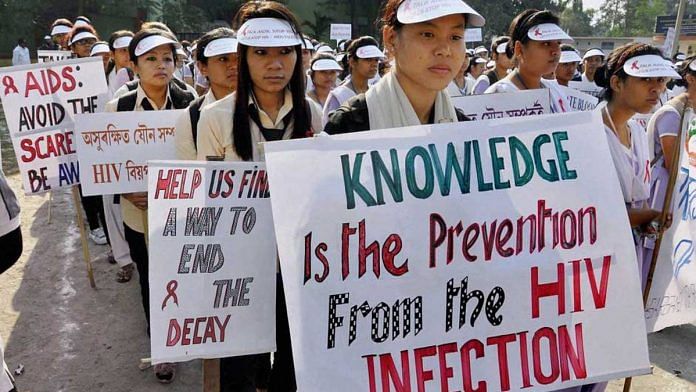New Delhi: With a global rise in sexually-transmitted diseases (STDs) and lack of reliable epidemiological data in India, the Indian Council of Medical Research (ICMR) is preparing to launch a hospital-based surveillance programme to monitor sexually-transmitted infections (STIs).
The nomenclature covers a wide variety of sexually-transmissible bacteria, viruses and parasites. Gonorrhoea, chlamydial infection, syphilis, trichomoniasis, chancroid, genital herpes, genital warts, human immunodeficiency virus (HIV) infection, and hepatitis B infection are among the most common diseases caused by them.
The programme will run for an initial period of three years and look at generating data on clinical signs and symptoms, laboratory investigations, management protocols, the clinical course of STIs, disease spectrum, and outcomes of patients.
The ICMR’s plan has been outlined in a public notice inviting letters of intent from scientific institutions.
“… Though the STI cases are widely evidenced in India, systematic epidemiological studies to determine their exact prevalence are yet not available,” the notice reads. “The World Health Organization (WHO) set targets for a 90 per cent reduction in the incidence of syphilis and gonorrhoea between 2018 and 2030. There is an utmost need for data on clinical signs and symptoms, laboratory investigations, management protocols, the clinical course of STI diseases, disease spectrum, and outcomes of patients. The data will serve as an invaluable tool in predicting the burden of the disease existing in our society,” it adds.
A community-based STI/RTI (reproductive tract infection) prevalence study conducted way back in 2002-03 by the ICMR estimated that 6 per cent of the adult population in India has one or more STI/RTIs. This, the government estimates, amounts to the occurrence of about 30-35 million episodes of STI/RTI every year in the country.
The proposed surveillance network will cover government healthcare institutions, designated RTI clinics, private hospitals and clinics, from which data will be collected to analyse trends and also detect patterns in antimicrobial resistance (AMR) in STIs found more commonly in India.
A large proportion of STIs occurs in young people. A 2007 study in the Indian Journal of Dermatology pegged the commonest age group in which STIs are detected as 20-29-year-olds.
Also read: Drug patented in 1960s can halve recovery time in mild & moderate Covid cases, study finds
Lack of recent national data
While the most commonly quoted number for national incidence remains the one from the ICMR study of 2002-03, there have been some local studies on incidence of STIs in India as well.
A 2008 study from Chennai found that herpes simplex is the most common STI.
“The most common prevalent STIs were herpes simplex virus (HSV)-2 (50 per cent of women, 29 per cent of men), syphilis (11 per cent of women, 8 per cent of men), and trichomonas vaginalis (6 per cent of women). At enrolment, women, participants with no schooling, participants with greater than four sex partners, and single participants were found to be at increased risk for HSV-2 infection,” reads the study, conducted by the non-profit YRG Centre for AIDS Research and Education and the Division of Infectious Diseases at Brown University, US.
The Indian Journal of Dermatology study, meanwhile, cites earlier research conducted in different cities that suggests a different pattern, including one in Chandigarh.
“Condyloma acuminata was the commonest STD (21.40 per cent), followed by gonorrhoea (16.9 per cent), chancroid (12.2 per cent), genital herpes (11.4 per cent), syphilis (10.4 per cent), non-specific ulcers (7.1 per cent), donovanosis (6.3 per cent), mixed infections (5.3 per cent) and NSU (4.1 per cent). What was obvious from this study is that viral STDs have started showing their dominance in an otherwise dominant bacterial STDs scenario,” reported the authors of that study.
Condyloma acuminata refers to genital warts caused by the human papillomavirus.
(Edited by Nida Fatima Siddiqui)
Also read: Behind Modi & Dr Tedros’ smiles in Gujarat, India & WHO are at war over Covid deaths, Covaxin



